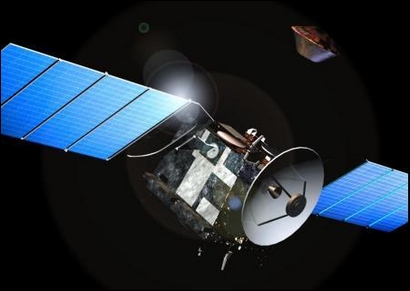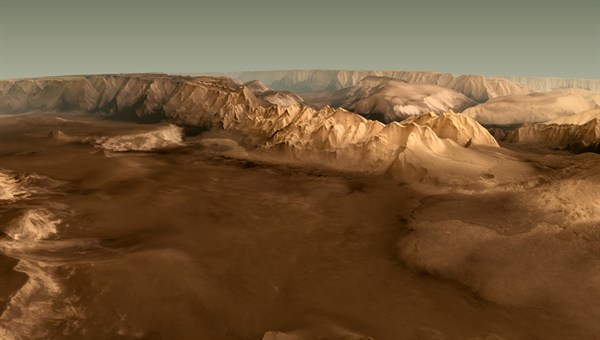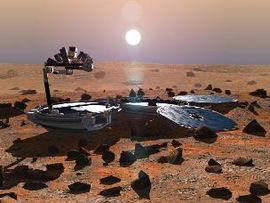Mars is the fourth planet from the Sun and our neighbor in the solar system. It is a very interesting planet referred to as the red planet because of its mysterious reddish surface appearance. Apart from Earth, it is the other planet with the highest possibility of supporting life either in the present or in the past. For this reason, it has intrigued scientists on Earth for a long time and we are really interested in finding more about it.

2003 was a great year in the history of Mars exploration. Three spacecrafts were launched on a mission to explore the red planet and unlock its secrets. One of these spacecrafts was the Mars Express Orbiter that is still orbiting Mars as of 2013.
What Was The Mars Express Mission?
Mars Express was the first spacecraft by the European Space Agency (ESA) to visit and orbit another planet. However, it was the second attempt by Europe to map the red planet after the devastating loss of the Mars 96 Probe.
Its objectives were to study the Martian surface and geology, investigate the presence of sub-surface water, and study the atmosphere and space environment from its position in orbit of Mars. It was also designed to investigate the history of water and potential for life on Mars.
It was mainly a European Space Agency (ESA) mission but NASA and the Italian Space Agency also played a part in this mission.
During its development, ESA was facing funding restrictions and Mars Express was a low cost and fast track mission. The development was so rapid and streamlined that it was named `express’. Most of its technology and components were borrowed from other missions.
The Mars Express spacecraft shares 80% of its design and components with the Rosetta spacecraft. Elements of the solar array structure were adapted from the Globalstar satellite series. Some of the scientific instruments onboard are spares or modified designs of the ones used in the ill fated Mars 96 Probe.
The Mars Express Spacecraft
The Mars Express Spacecraft had two parts: the Mars Express Orbiter and the Beagle 2 Lander that was attached to the top deck of the orbiter. The orbiter was supposed to orbit the planet to collect data and capture images while the Lander was supposed to land and study the surface and subsurface of the red planet.
The Instruments Onboard the Mars Express Orbiter
The orbiter is well equipped with high resolution instruments required to perform the experiments and realize the mission’s objectives.
The scientific payload contains 7 instruments designed to conduct a variety of investigations during the orbit around Mars.
Four of these instruments explore the Martian surface, imaging and analyzing it. The other three instruments on Mars Express study the atmosphere and space environment on Mars with a specific objective to find out the presence, abundance and characteristics of water vapor on Mars.
Instruments Studying the Surface of Mars
High Resolution Stereo Camera (HRSC), a color stereoscopic camera with a resolution of 12M, captures 3D images showing incredible details.
OMEGA, an infra-red mapping spectrometer, analyzes rock and soil samples in the infrared spectrum to uncover the mineral composition of the red planet.
Radio Science Experiment (RSE) studies the interior composition and geology of Mars.
Sub-surface Sounding Radar Altimeter (SSRA) measures the depth and composition of the Martian regolith.
Instruments Studying Mar’s Atmosphere and Space Environment
Energetic Neutral Atoms Analyzer (ASPERA) studies the Martian atmosphere and the effects of the solar wind on it.
Planetary Fourier Spectrometer (PFS) studies the atmosphere in infra-red making it possible to produce 3D charts of temperature and pressure.
UV Atmospheric Spectrometer (SPICAM) measures the composition and structure of the planet’s atmosphere.
Mars Advanced Radar for Subsurface and Ionospheric Sounding (MARSIS), the first radar sounder to orbit another planet, is mapping the interior of Mars and that of nearby objects.
The Mars Express Launch
The Mars Express spacecraft was launched on June 2 2003 on a Russian Soyuz-Fregat Rocket. It entered the orbit of Mars on Christmas day the same year.
The mission was originally intended to last one Martian year, which has 687 Earth days, but was later extended. The orbiter is expected to continue in the orbit of Mars until at least the end of year 2014.
Mars Express Orbit of the Red Planet
Mars Express follows a highly elliptical orbit as it revolves around Mars. The orbit is 250km by 11500 km inclined at an angle of 87 degrees. Its payload constraints limit the amount of propellant that could be carried and its construction makes it impossible to use aerobraking to correct the highly elliptical orbit.
Scientific observations started in early 2004 when the orbiter focused its instruments on the planet and started capturing data and images of Mars.
Apart from a glitch in October 2011 when the spacecraft went into safe mode due to a computer memory storage failure but later resumed normal operation, the rest of the mission has been smooth and successful.
Mars Express Findings and Accomplishments
The Mars Express Orbiter has remained in orbit of Mars since December 2003. In this period, it has captured a lot of data and images of the Red Planet. Since the mission is ongoing, there is the possibility for even more discoveries. Here are some of its remarkable discoveries and accomplishments so far:
Mars Express Finds Evidence of Water on Mars
The Mars Express Orbiter did not take long to accomplish one of its main objectives. On January 23 2004, less than a month of orbiting mars, the orbiter found signs of water existence on the planet. The HRSC camera spotted and captured images of ice caps made up of water ice and carbon dioxide ice at the South Pole. This finding was accurate, as scientists later confirmed that Mars South Polar cap is 85% carbon dioxide ice with 15% at its center. The spacecraft also proved that Mars has a supersaturated atmosphere.
Most recently in 2012, the Mars Express Orbiter discovered a possible ancient ocean on Mars evidenced by sediments found in the Northern plains. These sediments resemble the ones found on Earth’s oceans. This discovery was made after analyzing data collected by the MARSI radar over two years.
The MARSI radar which is the first radar instrument to study Mars has also made subsurface measurements discovering underground water ice deposits.
It has also found and transmitted mineralogical evidence of water presence, which proves that liquid water has existed on Mars throughout history.

Discovery of Methane in the Martian Atmosphere
Just a few weeks after the discovery of water existence on Mars, the orbiter made another significant discovery when it confirmed the presence of methane on Mars atmosphere becoming the first spacecraft to detect methane in the planet’s atmosphere from orbit.
Scientists were very excited after this discovery because methane does not usually last long in the atmosphere. To explain its existence, there had to be some form of fuel for methane on the planet’s surface. Scientists speculated that volcanoes were the source of methane but further investigations were required to confirm this. Later, the spacecraft found signs of Ammonia on Mars’ atmosphere.
Close Approach to Phobos
The orbiter’s unique orbit has enabled it to study one of Mars’ moons in details. The Orbiter flew close to Phobos, the larger of Mars’ two moons. In 2010, it approached Phobos coming as close as 42 miles (67km) making it the first and only spacecraft to come closest to this moon.
During this approach, it focused its instruments on the moon studying its inner structure and capturing close up images. Data transmitted from this encounter show that this moon may have resulted from a comet or meteorite colliding with the planet a long time ago.
Other Mars Express Findings
The orbiter is transmitting important data on the geology, mineralogy and atmosphere of Mars. By analyzing this data, astronomers will be able to understand the history of Mar’s climate as well as how long water has existed there.
MARSIS has transmitted data on Mars sub-surface features including buried impact carters, and layers of red deposits, which will contribute to understanding the history and composition of the red planet even more.
HRSC has captured and transmitted thousands of spectacular 3D images of Mars showing volcanoes, canyons, valleys, craters and polar ice caps in incredible details. It has found evidence of glacial activity and explosive volcanisms.

The spacecraft has investigated the density of the Martian crust and found out that the Martian aurora is unique from that of the other planets in the solar system.
Mars Express Beagle 2 Lander Declared Lost
So far, we have covered the Mars Express Orbiter mission, which went as planned. However, the Lander part of the mission did not go as planned.
Beagle 2 was a small probe that was developed by universities and companies in the UK. Its objective was to collect samples and capture close up images of Mars and it was equipped with the appropriate instrument among them a stereo camera and an analytical system to search for organic molecules under the Martian surface.
As planned, the Lander separated from left the spacecraft just before entry into Mars atmosphere. It was supposed to land in the Isidis Planitia region and make contact immediately. ESA lost contact with the Lander after the date it was supposed to land. After attempts to make contact with it in vain, it was declared lost in February 2004. No specific cause of failure was found after investigations. Nothing has been heard from the Lander ever since.
Apart from the lost Beagle 2, the rest of the Mars Express Mission has been a success. It has made discoveries that have increased our understanding of the history, evolution and composition of Mars. Its performance has been excellent and it continues to orbit the red planet sending even more data and images to Earth.


